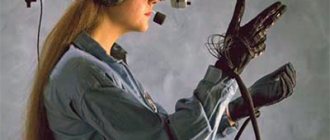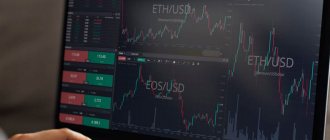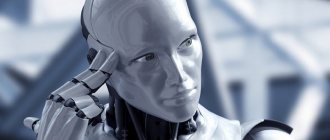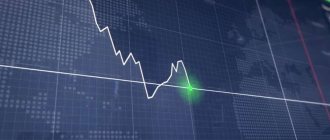Robotics is a department of applied science that deals with the design, production and use of automated technical systems - robots. A robot is a programmable mechanical device that can operate without human assistance.
Acting according to a pre-programmed program and receiving information about the outside world from sensors (analogs of the sensory organs of living organisms), the robot independently carries out production and other operations usually performed by humans or animals. In this case, the robot can both communicate with the operator (receive commands from him) and act autonomously.
Robots are manipulative and mobile:
- A manipulator with several degrees of mobility and a software device are responsible for performing the actions of a manipulation robot. Manipulation robots have become widespread in the mechanical engineering and instrument making industries.
- A mobile robot is more mobile than a manipulative one, since it has a moving chassis with automatically controlled drives - the “muscles” of the robots.
Classification of mobile robotics by type of movement
Modern robots, created on the basis of the latest achievements of science and technology, are used in all spheres of human activity. The appearance and design of modern robots can be very diverse.
Robotics can move on any surface, in water and in the air. So, according to the type of movement, robots are:
- Wheeled and tracked (the most common type of robots);
- Walking;
- Flying - autopilots and unmanned aerial vehicles;
- Crawling - move according to the principle of snakes and worms and are used to search for people under the rubble of collapsed buildings;
- Swimming - move in the water, imitating the movements of fish, and thereby become silent and very maneuverable;
- Moving along vertical surfaces - they act like a person, climbing the wall with the help of protrusions, or with the help of special suction cups.
The leaders in the production of robots at the moment are the companies FANUC (Japan), KUKA (Germany) and ABB (Sweden, Switzerland).
Example of a robot device - elements and design
Each robot consists of the following basic components:
- Robot frame or body;
- Control block;
- Manipulators;
- Chassis.
- Body/Frame: The body, or frame, of a robot can be of any shape or size. Initially, the body/frame provides the structure of the robot. Most people are familiar with humanoid robots used in filmmaking, but in reality, most robots have nothing in common with a human form. (NASA's Robonaft, introduced in the previous section, is an exception). Typically, a robot design focuses on functionality rather than appearance.
- Control System: The robot's control system is the equivalent of the human central nervous system. It is designed to coordinate the control of all elements of the robot. Sensors react to the robot’s interaction with the external environment. The sensor responses are sent to the central processing unit (CPU). The CPU processes data using software and makes decisions based on logic. The same thing happens when you enter a custom command.
- Manipulators: To perform a task, most robots interact with the external environment as well as the world around them. Sometimes it is necessary to move environmental objects without direct participation from operators. Manipulators are not an element of the basic design of the robot, like its body/frame or control system, that is, the robot can work without a manipulator. This course focuses on the topic of manipulatives, especially Unit 6.
- Chassis: While some robots can perform assigned tasks without changing their location, robots are often required to be able to move from one location to another. To perform this task, the robot needs a chassis. The chassis is a driving means of movement. Humanoid robots are equipped with legs, while the running gear of almost all other robots is implemented using wheels.
The robot can be of any shape and size. It is the frame or body of the robot that is the basis of its design and determines its appearance. The average person, when they hear the word “robot,” imagines a humanoid creature made of metal. This image is imposed by numerous science fiction films.
In fact, most robots are completely different from humans. The main thing for a robot is its functionality, not how it looks.
The robot's operation is controlled using a control system. It includes a huge number of sensors that help technology interact with the outside world.
The robot control system involves a whole set of algorithms, thanks to which certain tasks are solved. During robot operation, there is a constant exchange of data between sensors and the central processing unit (CPU). Algorithms and software are created by humans.
A manipulator is used for physical contact with objects in the external environment. This element is optional. Typically, the manipulator is not part of the robot's frame/body. Used to solve specific problems in various industries.
The robot's chassis is also optional, and is available only for those robots that need to move in space. Wheels are most often used as means of transportation.
Practical part
- Most of you want to create a robot not only for learning and gaining knowledge, but also for pure pleasure. Although many have their own specific ideas or projects that can be materialized.
- The last important point is the budget. It's difficult to understand exactly what people want when they build their first robots. Maybe they want to build an autonomous robot to clear snow, while someone else just wants to make a smartwatch. A simple programmable mobile robot can cost about $100. While more complex ones can cost several thousand dollars.
In this series of articles, a mobile platform will be created in order to understand what motors, sensors, microcontrollers and programming are. We will use the Lego Mindstorms EV3 educational set to create a mobile platform.
Basic components of robotics
The body of most robots consists of separate moving and fixed parts. Here are the main ones:
Internal controller. Each robot is equipped with a controller - a computer operating system. The controller is the brain of any robot. It contains all the necessary information to complete tasks and instructions.
Source of energy. Robots need a source of energy. Some run on batteries. Others are equipped with photovoltaic cells that convert sunlight into energy. Mechanical robots are wound up using a spring mechanism.
Remote control. Robots that operate on other planets, such as the Mars rover, have internal controllers, but can also be controlled from Earth.
Light and sound sensors. With their help, the robot can recognize light emanating from objects and detect sound waves. This function helps you either bypass various objects or go towards them. Also, a voice recognition device can be built into the robot body, with which a person gives verbal orders to the machine.
Pressure Sensors. Some robots are equipped with pressure sensors that simulate the sense of touch. These sensors have two purposes: they inform the robot that it has hit an object and must change direction, and they also allow it to correctly grasp and lift the object.
Actuators are the “muscles” of robots. Currently, the most popular motors in drives are electric, but others using chemicals or compressed air are also used. We list all the main drive options for robotics:
- DC Motors : Currently, most robots use electric motors, which can be of several types.
- Stepper Motors : As the name suggests, stepper motors do not spin freely like DC motors. They rotate step by step at a certain angle under the control of the controller. This allows you to do without a position sensor, since the controller knows exactly how much the turn was made. Because of this, they are often used in the drives of many robots and CNC machines.
- Piezo Motors : A modern alternative to DC motors are piezo motors, also known as ultrasonic motors. The principle of their operation is completely different: tiny piezoelectric legs, vibrating at a frequency of more than 1000 times per second, force the motor to move in a circle or straight line. The advantages of such engines are high nanometric resolution, speed and power, incommensurate with their size. Piezo motors are already available commercially and are also used on some robots.
- Air Muscles : Air muscles are a simple yet powerful device for providing traction. When pumped with compressed air, muscles can contract up to 40% of their length. The reason for this behavior is the weaving visible from the outside, which causes the muscles to be either long and thin or short and thick. Because the way they work is similar to biological muscles, they can be used to produce robots with muscles and skeletons similar to those of animals.
- Electroactive polymers : Electroactive polymers are a type of plastic that changes shape in response to electrical stimulation. They can be designed in such a way that they can bend, stretch or contract. However, there are currently no EAPs suitable for the production of commercial robots, as all are inefficient or fragile.
- Elastic nanotubes : This is a promising experimental technology in the early stages of development. The absence of defects in nanotubes allows this fiber to elastically deform by several percent. The human biceps can be replaced with a wire made of such material with a diameter of 8 mm. Such compact “muscles” could help robots in the future overtake and jump over humans.
What else will you need to study?
Programming _ It is possible to avoid it only at the initial stage, but then you can’t live without it. You can start with Lego Mindstorms, Python, ROS (Robot Operating System).
Basic mechanics. You can start with crafts made from paper, cardboard, bottles, which is important for fine motor skills and general development. The simplest robot can be made from individual parts (motors, wires, a photosensor and one simple microcircuit). The “Making Tool with Father Sperch” will help you get acquainted with the basic mechanics.
Basics of Electronics. First, learn how to assemble simple circuits. For children under eight years old, experts recommend the “Connoisseur” construction set; then you can move on to the “Basics of Electronics” set. Start".
Applications of robotics
Robots are used in a variety of fields, but the main ones are the following:
- Industry : industrial robots;
- Research activities : robot scientists, researchers;
- Combat robots : drones, sapper robots, security and safety;
- Nanotechnology : micro- and nano-robots for research and medical purposes;
- Home technologies : household robots, vacuum cleaners, window cleaners and personal ones.
In the industrial sector, robots make it possible to perform a large volume of work with high speed and accuracy. They allow us to solve problems that cannot be solved with human power.
Many places on our planet and beyond have not been explored for the reason that it is impossible for humans to do so. For example, we know about what is happening in the depths of the ocean and in space thanks to robotic explorers.
The growth of innovative technologies allows us to look optimistically into the future. Robotics is developing rapidly, opening up new opportunities for humanity.
Control systems
By controlling a robot we mean solving a set of problems related to adapting the robot to the range of tasks it solves, programming movements, and synthesizing a control system and its software.
Based on the type of control, robotic systems are divided into:
1. Biotechnical
:
1.1. command (push-button and lever control of individual parts of the robot);
1.2. copying (repetition of human movement, possible implementation of feedback that transmits the applied force, exoskeletons);
1.3. semi-automatic (control of one command element, for example, a handle, the entire kinematic circuit of the robot);
2. Automatic
:
2.1. software (function according to a predetermined program, mainly designed to solve monotonous problems in constant environmental conditions);
2.2. adaptive (solve standard problems, but adapt to operating conditions);
2.3. intelligent (the most developed automatic systems);
3. Interactive
:
3.1. automated (alternation of automatic and biotechnical modes is possible);
3.2. supervisory (automatic systems in which a person performs only target functions);
3.3. interactive (the robot participates in a dialogue with a person on choosing a behavioral strategy, and as a rule, the robot is equipped with an expert system that can predict the results of manipulations and give advice on choosing a goal).
Among the main tasks of robot control are the following:
- planning provisions;
- movement planning;
- planning of forces and moments;
- dynamic accuracy analysis;
- identification of kinematic and dynamic characteristics of the robot.
In the development of methods for controlling robots, the achievements of technical cybernetics and the theory of automatic control are of great importance.
What knowledge is needed to create robotics?
Modern robotics is based on knowledge from the fields of programming, mechanics, mechatronics, electrical engineering, electronics and automatic control.
To master robotics at a basic level, school knowledge of mathematics and physics is sufficient. Without understanding the physics of motion and the operating principles of mechanisms and electric motors, it is difficult to assemble a functioning robot.
Then come computer science and engineering. Since programming is as necessary in robotics as mathematics, it is important to understand computer science and information systems. Design will help create user-friendly products. But knowledge from other engineering disciplines will also be useful.
Main directions in the study of robotics:
- Mechanical engineering
studies the physical components of a robot—its “body.” Subtopics: mechanics and strength of materials. Most courses in this area focus on the physical design and operation of the robot. - Electrical and electronics engineering
or "nervous system" deals with the electrical systems inside a robot, embedded systems, low-level programming, and control theory. Typically this is automation that is built around robot control. - Computer science
- many specialists came to robotics due to their passion for computer science. Engineers in this field focus on robot software and high-level programming. Topics include artificial intelligence, navigation, technical vision, natural language processing, and so on.
How can you tell if your child has a penchant for robotics?
First you need to buy a construction set and see if your child likes assembling it. And then you can give it to the circle. Classes will help him develop fine motor skills, imagination, spatial perception, logic, concentration and patience.
The sooner you can decide on the direction of robotics - design, electronics, programming - the better. All three areas are vast and require separate study.
Alexander Kolotov, leading specialist in STEM programs at Innopolis University: “If a child likes to assemble construction sets, then construction will suit him. If he is interested in learning how things work, then he will enjoy doing electronics. If a child has a passion for mathematics, then he will be interested in programming.”
History of the development of robotics over the past 100 years
A brief history of the formation and development of robotics, indicating the most significant events and developments:
- 1913 Charles Macauley's creation of a machine that finds solutions to logical problems.
- 1921 The first mention of the word "robot" (robota from Czech) in the play "RUR" The play was written by Karel Capek in 1920 ("RUR" from Czech: Rossumovi univerzalna roboti, "Rossum's Universal Robots"). On January 25, 1921, the play premiered.
- 1934 Creation of an industrial conveyor robot for painting surfaces.
- 1946 Presentation of the mechanism for controlling machines using a magnetic recording device.
- 1950s. Active development of mechanical manipulators that copied the movement of human hands for implementation in radioactive production.
- 1963 The Rancho Arm, an artificial hand comparable to a human one, is on display at an exhibition in California.
- 1971 Invention of the world's first microprocessor.
- 1980 The strongest surge in the growth of the robotics market, which occurred thanks to the commercial sale of Japanese robots produced on the basis of high technology.
- 1992 During the development of a robot vacuum cleaner, Mark Thorpe came up with the idea of organizing robot fights.
- year 2000. The Electrolux company presented the Trilobite robot vacuum cleaner on BBC television, which independently moved around the room and collected dust.
- year 2001. Invention of the flexible FOLED display, which used flexible plastic (or metal plate) as a substrate.
- 2002 marked the beginning of the tablet era, at the origins of which was the Microsoft Tablet PC - the first tablet computer.
- 2003 QRIO is released. The child's robot, which has the basis for adaptive behavior, can balance while standing on one leg, uses more than 60,000 words in speech and dances.
- 2003 4 years after the invention of the Trilobite robot vacuum cleaner, Electrolux is releasing the second generation of this model. The improvements affected not only the design, but also the functionality: it “learned” to avoid obstacles, “knew” when to return to the charger, and the noise level was significantly reduced.
- 2004 Mark Tilden creates the first commercially successful robot toy, Robosapien.
- 2005 year. Military robotics became famous with the invention of the PackBot with the REDOWL system. The anti-sniper program distinguished the sound of a shot from all others and accurately determined the coordinates of the shooter. Then, the laser sight was aimed at the target.
- 2006 The NEC System Technologies laboratory presented a robot taster. In addition to being able to recognize the product, it gave advice on pairing snacks and drinks in less than half a minute.
- 2007 Tests of the test police robot R-BOT 001, conducted by the Russian Ministry of Internal Affairs in the city of Perm.
- 2008 The European Council for Nuclear Research has developed a project for the Large Hadron Collider, designed to study the products of collisions at high speeds of protons and heavy ions.
- year 2009. Creation of the first biological 3D printer capable of recreating the architecture of body tissue at the micro level.
- 2010 The Korean company Ilshim Global is presenting the world's first window cleaning robot, Windoro, which independently determines the size of the surface and builds a route.
- 2011. NASA robot Robonaut 2 was delivered to the ISS.
- 2011. The Inventist company, led by Shane Chen, patents the first unicycle, Solowheel, which differs from earlier analogues in the absence of a seat and the presence of a gyroscope system. Innovations made it possible to establish mass production of the device.
- year 2012. Military scientific developments in the field of explosives led to the discovery of the most powerful explosive to date - hexanitrohexaazaisovycytan.
- year 2013. A Japanese-made robotic astronaut arrives at the International Space Station.
- year 2013. The first two-wheeled self-balancing vehicle, the hoverboard, was patented.
- year 2014. Wireless electricity. The first successful tests of a coil generating an electric field. This invention allows you to charge electronic devices within a radius of 2.5 meters, freeing them from sockets and wires.
- 2015 A real revolution in the electric automobile industry was the presentation of the Tesla Model X SUV, which is capable of covering 402 km without recharging. And acceleration to 100 km/h is carried out in 3 seconds.
- 2016 Medical research aimed at helping people suffering from cognitive impairment has led to the creation of the Eatwell Assistive Tableware collection. It is designed taking into account all the eating habits of people with Alzheimer's disease.
- From 2022. The main direction of robotics is the progress of artificial intelligence. The main goal of the developments is to train AI to self-develop, instantly adapt to changing environmental factors, and find the optimal solution to assigned tasks.
Where can I get an education in robotics?
GeekUniversity together with Mail.ru Group opened the first Artificial Intelligence faculty in Russia teaching programming for robotics.
School knowledge is enough for studying. You will have all the necessary resources and tools + a whole program in higher mathematics. Not abstract, as in ordinary universities, but built in practice. The training will introduce you to machine learning technologies and neural networks, and teach you how to solve real business problems.
After studying you will be able to work in the following specialties:
- Artificial intelligence,
- Machine learning,
- Neural networks,
- Big data analysis.
Features of studying at GeekUniversity
After a year and a half of practical training, you will master modern Data Science technologies and acquire the competencies necessary to work in a large IT company. Receive a professional retraining diploma and certificate.
Training is conducted on the basis of state license No. 040485. Based on the results of successful completion of training, we issue graduates with a diploma of professional retraining and an electronic certificate on the GeekBrains and Mail.ru Group portals.
Project-based learning
Training takes place in practice; programs are developed jointly with specialists from market leading companies. You will solve four data science project problems and apply the skills you learn in practice. A year and a half of training at GeekUniversity = a year and a half of real world big data experience for your resume.
Mentor
During the entire training you will have a personal assistant-curator. With it, you can quickly sort out all the problems that would otherwise take weeks. Working with a mentor doubles the speed and quality of learning.
Thorough mathematical training
Professionalism in Data Science is 50% ability to build mathematical models and another 50% ability to work with data. GeekUniversity will improve your knowledge in mathematical analysis, which will definitely be tested during an interview at any serious company.










